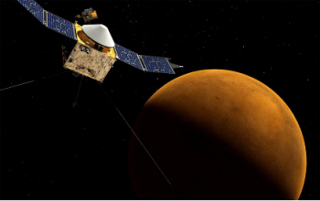
Ocean Covered Northern Hemisphere of Mars
A new NASA study, based on six years of observations, has led researchers to the belief that a vast ocean once covered Mars’ surface. Evidence suggests that the body of water was the size of Earth’s Arctic Ocean, much larger than what researchers had previously thought, and that it covered the low-lying northern plains of Mars for millions of years.
MARYLAND. A new NASA study, based on six years of observations, has led researchers to the belief that a vast ocean once covered Mars’ surface. Evidence suggests that the body of water was the size of Earth’s Arctic Ocean, much larger than what researchers had previously thought, and that it covered the low-lying northern plains of Mars for millions of years.
If these estimates, announced last March, are confirmed, they will illuminate many dark secrets in the history of the Red Planet and strengthen the theory that Mars possessed all the elements required to sustain life in its distant geological past. As Michael Mumma, senior scientist at NASA’s Goddard Space Flight Center in Maryland, pointed out last spring, “The existence of a northern ocean has been discussed for decades. This, however, is the first time we have so many pieces of evidence to attest to this.” Dr. Mumma and Geronimo Villanueva, a planetary scientist, measured two different types of water in Mars’ atmosphere. One is the standard H2O, consisting of two hydrogen atoms and one oxygen atom. The second is a slightly “heavier” form of water, HDO, whose hydrogen atom contains one neutron in its nucleus. This hydrogen atom is called deuterium.
Both types of water exist on Earth in expected proportions, and both have been detected on Martian meteorites. Higher levels of deuterium would mean that at one time the planet had larger quantities of “lighter” water, which somehow were lost as the planet evolved.
NASA’s rover “Curiosity” detected both light and heavy water molecules on Mars’ Gale Crater, although these measurements do not lead to the conclusion that an entire ocean existed on the planet’s surface.
“The more water that existed on Mars, particularly if the water was extended and remained there for a long period of time, the greater the chances of the planet being habitable and capable of sustaining life,” explained Paul Mahaffy, chief of atmospheric experiments at the Goddard Laboratory.
In early 2015, a team of scientists concluded that the area of the Gale Crater, where “Curiosity” has tirelessly carried out its mission, hosted lakes for millions of years. However, no one knows how these lakes were preserved or supplied with water. “The existence of long-standing lakes for millions of years means that the planet had large volumes of outdoor water, necessary for the supply of moisture and water to these lakes. If there were no ocean, the water in the lakes would evaporate and be transported to the poles where it would freeze,” said Dr. Villanueva.
Special climatologists, however, raise the following valid question: How could a geologically primitive Mars be warm enough to maintain water in a liquid state? While greenhouse gases would be able to heat the planet significantly, their byproducts have not yet been identified on the surface, thus intensifying the mystery.
Source: Kathimerini Newspaper 09/29/2015, Rueters
For more information, read also the following article (in Greek): Τρεχούμενο νερό στον Κόκκινο Πλανήτη
